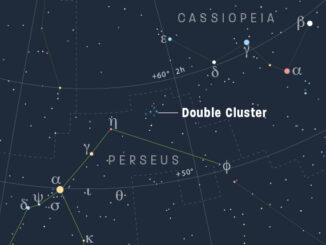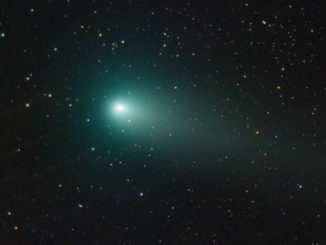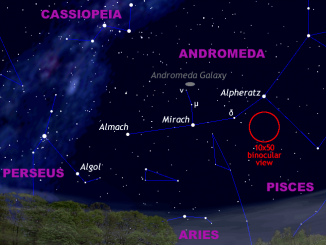
Perseus


Get ready for Comet ATLAS (C/2019 Y4) in the northern spring sky!
Comet C/2019 Y4 was discovered by the Asteroid Terrestrial-impact Last Alert System (ATLAS) on 28 December last year and brightened 6000-fold in just two months to attain magnitude +7.5 on 1 April. Alas, the comet’s nucleus has now fragmented, dashing hopes for a conspicuous naked-eye spectacle in the constellation of Perseus. Here’s our telescopic observing guide.

Hunting for colourful double and triple stars in the constellation of Cassiopeia
The instantly recognisable five-star M-shaped pattern of stars representing the constellation Cassiopeia (pronounced kas-ee-uh-pee-uh) lies almost overhead in the early evening as seen from the British Isles over the festive period. Cassiopeia is rich in wonderful double and multiple stars, so here’s our guide to some of the best for typical backyard telescopes.

Catch close Comet 46P/Wirtanen near the Pleiades on 16 December
Bright Comet 46P/Wirtanen skims past Earth just 30 lunar distances away on 16 December when it could become a diffuse magnitude +3 object almost a degree wide located between the Pleiades and Aldebaran in the constellation of Taurus. Grab your binoculars and find a dark sky location well away from streetlights to enjoy this Christmas comet before the glow from a waxing Moon gets too bright from 17 December.

See bright Comet 21P’s close brush with conspicuous Capella
If you’ve never seen a comet, there’s currently a bright example visible in the late evening about to make a close approach to the 6th brightest star in the night sky on the UK night of 2–3 September. We show you how to find Comet 21P/Giacobini-Zinner around the time it passes within a degree of prominent star Capella.

Don’t miss 2018’s favourable Perseid meteor shower, 12–13 August
From the UK evening of Sunday, 12 August into the early hours of the following morning it’s the maximum of the annual Perseid meteor shower. This year, a new Moon setting in twilight makes prospects for watching this natural firework display particularly good. So, find somewhere away from the streetlights, settle into a garden lounger facing northeast and enjoy the show!

See asteroid 2018 CB’s close encounter on 9 February
As darkness falls over Western Europe on the evening of 9 February, near-Earth asteroid 2018 CB lies almost overhead as seen from the UK. We show you how and when to find this 30-metre-wide space rock as it speeds through the constellations of Perseus and Triangulum, passing just one-fifth of the Moon’s distance away at 22:27 UT (10:27pm GMT).

See asteroid Phaethon, source of the Geminids, in a close brush with Earth
As shooting-star devotees prepare for the naked-eye spectacle of the Geminid meteor shower in mid-December, owners of small telescopes can also witness the close passage of the meteors’ parent body — a curious “rock comet” known as 3200 Phaethon, galloping through the constellations of Auriga, Perseus, Andromeda, Pisces and Pegasus at a rate of up to 15 degrees/day.


Get ready for the Perseid meteor shower peak of 11-12 August
With a waxing gibbous Moon setting at 1am BST for the UK on the night of 12-13 August, observers will have dark skies for what could be a Perseid meteor shower to remember. Some theorists believe that Jupiter’s gravitational influence has deflected more particles from parent comet 109P/Swift-Tuttle into Earth’s path for a spectacular show.
